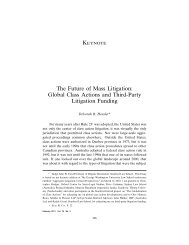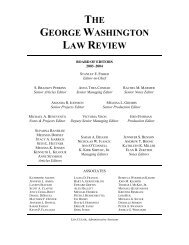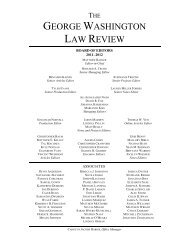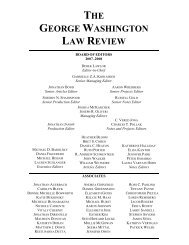View PDF - The George Washington Law Review
View PDF - The George Washington Law Review
View PDF - The George Washington Law Review
Create successful ePaper yourself
Turn your PDF publications into a flip-book with our unique Google optimized e-Paper software.
6 THE GEORGE WASHINGTON LAW REVIEWARGUENDO [Vol. 82<br />
tion which can only be decided in the concrete factual context of<br />
the individual case. 23<br />
Judge Scheindlin never explained why Floyd differs from Sibron. If<br />
there were a large number of unlawful stops and frisks, that number could<br />
justify the inference that New York City had a policy of encouraging unlawful<br />
police practices, but the answer to the latter inquiry is secondary to,<br />
and hinges on, the answer to the former.<br />
II.<br />
THE EQUAL PROTECTION CLAUSE<br />
<strong>The</strong> court’s discussion of the Fourth Amendment may turn out to be of<br />
little importance. <strong>The</strong> nonstatistical evidence on which Judge Scheindlin<br />
relied—e.g., the gross number of stops of blacks and Hispanics, the pressure<br />
from NYPD commanders to increase the number of stops, the NYPD’s<br />
indifference to the legality of those stops and frisks, and evidence of what<br />
the judge termed “indirect racial profiling” 24 —may support the inference<br />
that the City violated the Equal Protection Clause regardless of whether the<br />
NYPD stop-and-frisk practice violates the Fourth Amendment. <strong>The</strong> two<br />
inquiries are distinct. <strong>The</strong> latter requires examination of the facts and circumstances<br />
of each separate stop and frisk, 25 whereas the former asks<br />
whether senior NYPD or City officials adopted a stop-and-frisk policy<br />
based on impermissible racial criteria and encouraged police officers to<br />
rely on it when confronting people on the street. 26<br />
A government practice can violate the Equal Protection Clause if it<br />
discriminates because of an immutable characteristic, such as race, or if it<br />
is the product of discriminatory animus. 27 By contrast, a facially neutral,<br />
benignly intended, and evenhandedly applied practice is not unconstitutional<br />
even if it has a disparate impact on a minority group. Proof that the<br />
decisionmaker acted, at least in part, to achieve that result is necessary. 28<br />
23 Id. at 59; see also Nicholas Quinn Rosenkranz, <strong>The</strong> Objects of the Constitution, 63<br />
STAN. L. REV. 1005, 1036 (2011) (“Congress cannot violate this clause by authorizing a<br />
search; only the President can violate it, and only by executing a search.”).<br />
24 See Floyd, 2013 WL 4046209, at *24–25, *30, *34–36, *42, *72.<br />
25 See supra text accompanying notes 17, 22–23.<br />
26 See infra text accompanying notes 28–30.<br />
27 See, e.g., Adarand Constructors, Inc. v. Pena, 515 U.S. 200, 237–39 (1995) (subjecting<br />
a facially discriminatory federal statute to strict scrutiny and remanding for application<br />
of that test); Hunter v. Underwood, 471 U.S. 222, 233 (1985) (holding unconstitutional<br />
a facially neutral state constitutional provision enacted for a racially discriminatory purpose).<br />
28 See, e.g., United States v. Armstrong, 517 U.S. 456, 463–67 (1996); McCleskey v.<br />
Kemp, 481 U.S. 279, 292–93 (1987); Pers. Adm’r v. Feeney, 442 U.S. 256, 279 (1979);<br />
Village of Arlington Heights v. Metro. Hous. Dev. Corp., 429 U.S. 252, 266 (1977); Wash-









